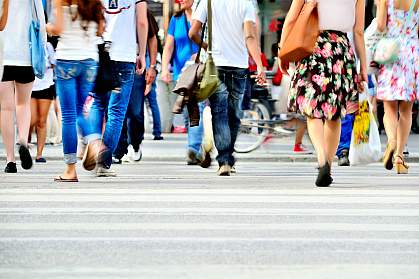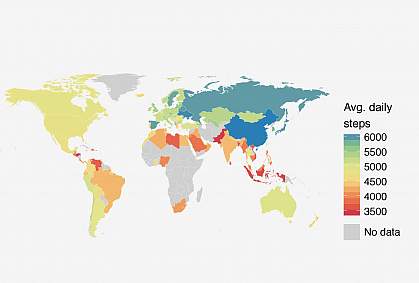You are here
July 25, 2017
Tracking physical activity around the world
At a Glance
- An analysis of global smartphone data found that a wider gap between active and sedentary people within a country corresponds with higher rates of obesity.
- The study demonstrates the ability to pool large volumes of smartphone data to reveal new insights that might help guide public health policy and urban planning.

Physical activity is essential for good health. It helps with weight control and reduces the risk of many diseases. A recent study estimated that more than 5 million people in the world die each year from causes linked to too little physical activity.
Previous studies of the effects of physical activity on health have often relied on survey data. Today, researchers are using smartphone trackers that automatically count steps and record other health measurements. Almost three-quarters of adults in developed countries and nearly half of those in developing economies carry a smartphone.
A research team led by Drs. Jure Lekovec and Scott Delp of Stanford University used smartphone data to track physical activity in countries around the world. The study was supported in part by NIH’s Big Data to Knowledge Initiative and managed by NIH’s National Institute of Biomedical Imaging and Bioengineering (NIBIB), Eunice Kennedy Shriver National Institute of Child Health and Human Development (NICHD), and National Institute of Neurological Disorders and Stroke (NINDS). Results appeared online on July 10, 2017, in Nature.

The researchers analyzed 68 million days of step recordings from more than 717,000 anonymous users of the free Azumio Argus smartphone app. Data were collected from users in 111 countries. The team decided to focus their study on the 46 countries that had at least 1,000 users. In those countries, 90% of users were from 32 high income countries and 10% were from 14 middle income countries. Globally, the average user recorded about 5,000 steps per day. In addition to step records, the researchers accessed the age, gender, height, and weight of the users.
The team compared levels of activity within each country and calculated each country’s activity inequality—the gap between people with low physical activity and those with high activity. The countries with the greatest activity inequality, they found, also had the greatest obesity problems. People in the five countries with the greatest activity inequality were nearly 200% more likely to be obese than those from the five countries with the lowest activity inequality.
Data from 69 U.S. cities showed that higher walkability scores were associated with lower activity inequality. These scores measure city block length and other factors that affect how easy it is to walk to shops and parks. Higher walkability was associated with significantly more daily steps regardless of age, gender, or body mass index.
“These results reveal how much of a population is activity-rich, and how much of a population is activity-poor,” Delp explains. “In regions with high activity inequality, there are many people who are activity-poor, and activity inequality is a strong predictor of health outcomes.”
Pooling smartphone data from users around the world can uncover patterns in health behaviors and suggest new strategies for improving health and wellness.
Related Links
- Physical Activity Associated with Lower Risk of Many Cancers
- Physical Activity May Reduce Age-Related Movement Problems
- A Little Exercise Might Lengthen Life
- Moderate Exercise May Improve Memory in Older Adults
- Biosensors and Your Health: What’s Your Body Trying to Tell You?
- Sensors
References: Large-scale physical activity data reveal worldwide activity inequality. Althoff T, Sosič R, Hicks JL, King AC, Delp SL, Leskovec J. Nature. 2017 Jul 10. doi: 10.1038/nature23018. [Epub ahead of print]. PMID: 28693034.
Funding: NIH’s Big Data to Knowledge Initiative, National Institute of Biomedical Imaging and Bioengineering (NIBIB), Eunice Kennedy Shriver National Institute of Child Health and Human Development (NICHD), and National Institute of Neurological Disorders and Stroke (NINDS); National Science Foundation; and Stanford Data Science Initiative.
